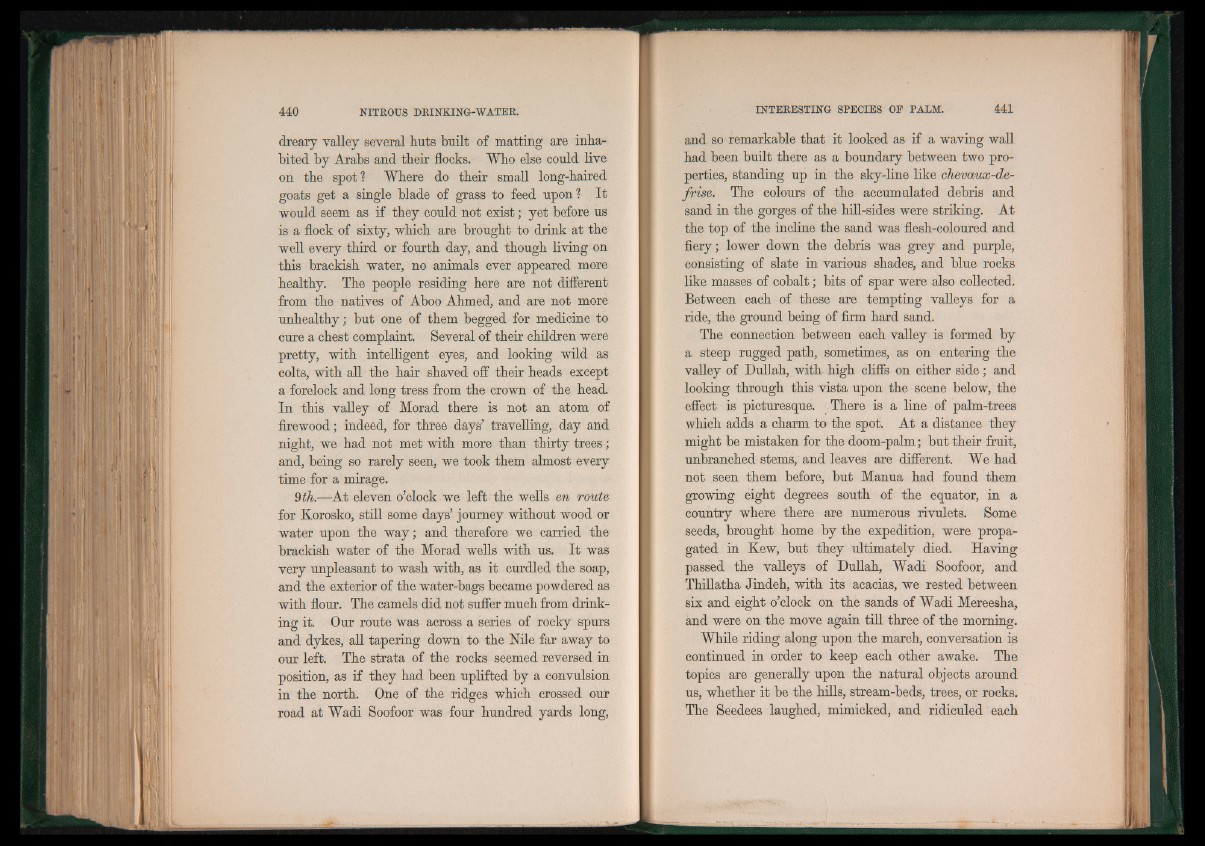
dreary valley several huts built of matting are inhabited
by Arabs and their flocks. Who else could live
on the spot? Where do their small long-haired
goats get a single blade of grass to feed upon? It
would seem as if they could not exist; yet before us
is a flock of sixty, which are brought to drink at the
well every third or fourth day, and though living on
this brackish water, no animals ever appeared more
healthy. The people residing here are not different
from the natives of Aboo Ahmed, and are not more
unhealthy; but one of them begged for medicine to
cure a chest complaint. Several of their children were
pretty, with intelligent eyes, and looking wild as
colts, with all the hair shaved off their heads except
a forelock and long tress from the crown of the head.
In this valley of Morad there is not an atom of
firewood; indeed, for three days’ travelling, day and
night, we had not met with more than thirty trees;
and, being so rarely seen, we took them almost every
time for a mirage.
9 th,—At eleven o’clock we left the wells en route
for Korosko, still some days’ journey without wood or
water upon the way; and therefore we carried the
brackish water of the Morad wells with. us. It was
very unpleasant to wash with, as it curdled the soap,
and the exterior of the water-bags became powdered as
with flour. The camels did not suffer much from drinking
it. Our route was across a series of rocky spurs
and dykes, all tapering down to the Nile far away to
our left. The strata of the rocks seemed reversed in
position, as if they had been uplifted by a convulsion
in the north. One of the ridges which crossed our
road at Wadi Soofoor was four hundred yards long,
and so remarkable that it looked as if a waving wall
had been built there as a boundary between two properties,
standing up in the sky-line like chevaux-de-
frise. The colours of the accumulated debris and
sand in the gorges of the hill-sides were striking. At
the top of the incline the sand was flesh-coloured and
fiery; lower down the debris was grey and purple,
consisting of slate in various shades, and blue rocks
like masses of cobalt; bits of spar were also collected.
Between each of these are tempting valleys for a
ride, the ground being of firm hard sand.
The connection between each valley is formed by
a steep rugged path, sometimes, as on entering the
valley of Dullah, with high cliffs on either side; and
looking through this vista upon the scene below, the
effect is picturesque. There is a line of palm-trees
which adds a charm to the spot. At a distance they
might be mistaken for the doom-palm; but their fruit,
unbranched stems, and leaves are different. We had
not seen them before, but Manua had found them
growing eight degrees south of the equator, in a
country where there are numerous rivulets. Some
seeds, brought home by the expedition, were propagated
in Kew, but they ultimately died. Having
passed the valleys of Dullah, Wadi Soofoor, and
Thillatha Jindeh, with its acacias, we rested between
six and eight o’clock on the sands of Wadi Mereesha,
and were on the move again till three of the morning.
While riding along upon the march, conversation is
continued in order to keep each other awake. The
topics are generally upon the natural objects around
us, whether it be the hills, stream-beds, trees, or rocks.
The Seedees laughed, mimicked, and ridiculed each